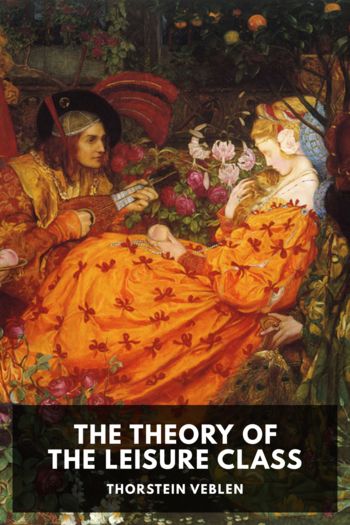The Theory of the Leisure Class by Thorstein Veblen (phonics readers TXT) 📕

- Author: Thorstein Veblen
Book online «The Theory of the Leisure Class by Thorstein Veblen (phonics readers TXT) 📕». Author Thorstein Veblen
Apart from their serviceability in other respects, these objects are beautiful and have a utility as such; they are valuable on this account if they can be appropriated or monopolized; they are, therefore, coveted as valuable possessions, and their exclusive enjoyment gratifies the possessor’s sense of pecuniary superiority at the same time that their contemplation gratifies his sense of beauty. But their beauty, in the naive sense of the word, is the occasion rather than the ground of their monopolization or of their commercial value. “Great as is the sensuous beauty of gems, their rarity and price adds an expression of distinction to them, which they would never have if they were cheap.” There is, indeed, in the common run of cases under this head, relatively little incentive to the exclusive possession and use of these beautiful things, except on the ground of their honorific character as items of conspicuous waste. Most objects of this general class, with the partial exception of articles of personal adornment, would serve all other purposes than the honorific one equally well, whether owned by the person viewing them or not; and even as regards personal ornaments it is to be added that their chief purpose is to lend éclat to the person of their wearer (or owner) by comparison with other persons who are compelled to do without. The aesthetic serviceability of objects of beauty is not greatly nor universally heightened by possession.
The generalization for which the discussion so far affords ground is that any valuable object in order to appeal to our sense of beauty must conform to the requirements of beauty and of expensiveness both. But this is not all. Beyond this the canon of expensiveness also affects our tastes in such a way as to inextricably blend the marks of expensiveness, in our appreciation, with the beautiful features of the object, and to subsume the resultant effect under the head of an appreciation of beauty simply. The marks of expensiveness come to be accepted as beautiful features of the expensive articles. They are pleasing as being marks of honorific costliness, and the pleasure which they afford on this score blends with that afforded by the beautiful form and color of the object; so that we often declare that an article of apparel, for instance, is “perfectly lovely,” when pretty much all that an analysis of the aesthetic value of the article would leave ground for is the declaration that it is pecuniarily honorific.
This blending and confusion of the elements of expensiveness and of beauty is, perhaps, best exemplified in articles of dress and of household furniture. The code of reputability in matters of dress decides what shapes, colors, materials, and general effects in human apparel are for the time to be accepted as suitable; and departures from the code are offensive to our taste, supposedly as being departures from aesthetic truth. The approval with which we look upon fashionable attire is by no means to be accounted pure make-believe. We readily, and for the most part with utter sincerity, find those things pleasing that are in vogue. Shaggy dress-stuffs and pronounced color effects, for instance, offend us at times when the vogue is goods of a high, glossy finish and neutral colors. A fancy bonnet of this year’s model unquestionably appeals to our sensibilities today much more forcibly than an equally fancy bonnet of the model of last year; although when viewed in the perspective of a quarter of a century, it would, I apprehend, be a matter of the utmost difficulty to award the palm for intrinsic beauty to the one rather than to the other of these structures. So, again, it may be remarked that, considered simply in their physical juxtaposition with the human form, the high gloss of a gentleman’s hat or of a patent-leather shoe has no more of intrinsic beauty than a similarly high gloss on a threadbare sleeve; and yet there is no question but that all well-bred people (in the Occidental civilized communities) instinctively and unaffectedly cleave to the one as a phenomenon of great beauty, and eschew the other as offensive to every sense to which it can appeal. It is extremely doubtful if anyone could be induced to wear such a contrivance as the high hat of civilized society, except for some urgent reason based on other than aesthetic grounds.
By further habituation to an appreciative perception of the marks of expensiveness in goods, and by habitually identifying beauty with reputability, it comes about that a beautiful article which is not expensive is accounted not beautiful. In this way it has happened, for instance, that some beautiful flowers pass conventionally for offensive weeds; others that can be cultivated with relative ease are accepted and admired by the lower middle class, who can afford no more expensive luxuries of this kind; but these varieties are rejected as vulgar by those people who are better able to pay for expensive flowers and who are educated to a higher schedule of pecuniary beauty in the florist’s products; while still other flowers, of no greater intrinsic beauty than these, are cultivated at great cost and call out much admiration from flower-lovers whose tastes have been matured under the critical guidance of a polite environment.
The same variation in matters of taste, from one class of society to another, is visible also as regards many other kinds of consumable goods, as, for example, is the case with furniture, houses,





Comments (0)